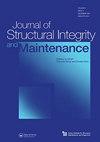含工业废渣骨料水泥砂浆界面特性研究
IF 3.1
Q2 ENGINEERING, CIVIL
Journal of Structural Integrity and Maintenance
Pub Date : 2020-09-17
DOI:10.1080/24705314.2020.1783124
引用次数: 5
摘要
摘要在本研究中,通过背散射电子(BSE)图像分析对含有贵矿渣(PS)球的水泥砂浆的孔隙率进行了评估。贵矿渣球是一种通过矿渣雾化技术快速冷却炼钢过程中产生的矿渣而产生的工业废物。制备掺有PS的砂浆,随后对其抗压强度进行评估。采用孔隙分割方法对BSE图像进行分析。使用Otsu的阈值方法对图像进行二值化,然后确定孔隙率。由于界面属性是主要关注的问题,因此确定了从骨料表面到100μm宽度的孔隙率。共分析了24个切片,并绘制了平均值。尽管掺入PS球的砂浆在28天龄期的强度降低了10%,但与含砂的普通砂浆相比,它在(从颗粒表面到35μm宽)之间表现出更强和更少的骨料-基质界面,这是由潜在的化学结合导致的PS球的化学组成所证明的。此外,孔隙率随着与集料表面距离的增加而降低。虽然PS Ball的使用是环保的,但其增强的界面性能以及由此产生的水泥砂浆的一些强度损失鼓励其在可持续建筑材料中的使用。本文章由计算机程序翻译,如有差异,请以英文原文为准。
Interfacial characteristics of cement mortars containing aggregate derived from industrial slag waste
ABSTRACT In this study, porosity assessment of cement mortars containing Precious Slag (PS) Ball – an industrial waste produced by rapid cooling of slag generated from steel making process by Slag Atomizing Technology – is done by Back-Scattered Electron (BSE) image analysis. PS incorporated mortars were fabricated and subsequently evaluated for compressive strength. BSE images were analyzed by pore segmentation method. Binarization on the images using Otsu’s thresholding method was done followed by the porosity determination. As the interfacial attributes were the primary concern, the porosity was determined from the aggregate surface to the 100 μm width. A total of 24 sections were analyzed and the mean values were plotted. Although the PS Ball incorporated mortar exhibited 10% lower strength at 28-day age, it showed stronger and less porous aggregate- matrix interface between (from particle surface up to 35 μm width) as compared to that of normal mortar containing sand, which is justifiable by the chemical composition of PS Ball attributed to the potential chemical binding. Further, the porosity decreased as the distance from aggregate surface increased. While the use of PS Ball is environmentally friendly, its enhanced interfacial properties with some strength loss of resulting cement mortars encourages its use in sustainable construction materials.
求助全文
通过发布文献求助,成功后即可免费获取论文全文。
去求助
来源期刊

Journal of Structural Integrity and Maintenance
ENGINEERING, CIVIL-
CiteScore
3.90
自引率
9.50%
发文量
24
 求助内容:
求助内容: 应助结果提醒方式:
应助结果提醒方式:


